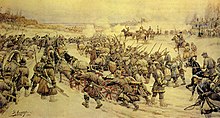This article needs additional citations for verification. (June 2023) |
| Uprising of Bolotnikov | |||||||
|---|---|---|---|---|---|---|---|
| Part of Time of Troubles | |||||||
 Ernest Lissner. The beginning of the battle of Bolotnikov's troops with the tsar's troops near the village of Nizhniye Kotly near Moscow | |||||||
| |||||||
| Belligerents | |||||||
| Russian Kingdom |
Rebels (supporters of False Dmitry): Don Cossacks Volga Cossacks Terek Cossacks Ukrainian Cossacks Service People Posad People Peasants (serfs and black-ploughing) Foreign mercenaries (Polish-Lithuanian and German) | ||||||
| Commanders and leaders | |||||||
|
Vasily IV Shuisky Fedor Mstislavsky Yuri Trubetskoy Ivan Vorotynsky Ivan Shuisky Dmitry Shuisky Artemy Izmailov Mikhail Skopin-Shuisky Mikhail Shein From the end of 1606: Philip (Istoma) Pashkov † Grigory Sunbulov Prokopy Lyapunov |
Ivan Bolotnikov † Grigory Shakhovskoy Andrey Telyatevsky Ilya Korovin (Ileika Muromets, False Peter) † Yuri Bezzubtsev Until the end of 1606: Philip (Istoma) Pashkov Grigory Sunbulov Prokopy Lyapunov | ||||||
| Strength | |||||||
| From 50–60 to 100 thousand or more people[1] | Up to 25–30 thousand people[1] | ||||||
The Uprising of Bolotnikov,[1] in Russian historiography called the Peasant War under the Leadership of Ivan Bolotnikov (Peasant Uprising),[2][3] was a major peasant, Cossack, and noble uprising of 1606–1607 led by Ivan Bolotnikov and several other leaders. At the time of the highest point of the uprising (the Siege of Moscow in 1606), more than 70 cities in the south and center of Russia were under the control of the rebels.
- ^ a b c Bolotnikov's Uprising // Great Russian Encyclopedia: in 35 Volumes / Editor-in-Chief Yuri Osipov – Moscow: Great Russian Encyclopedia, 2004–2017
- ^ Peasant War under the Leadership of Ivan Bolotnikov // N – Nikolaev – Moscow: Soviet Encyclopedia, 1954 – Page 361 – (Great Soviet Encyclopedia: in 51 Volumes / Editor-in-Chief Boris Vvedensky; 1949–1958, Volume 29)
- ^ Peasant Uprising led by Ivan Bolotnikov // Soviet Historical Encyclopedia: in 16 Volumes / Edited by Evgeny Zhukov – Moscow: Soviet Encyclopedia, 1961–1976